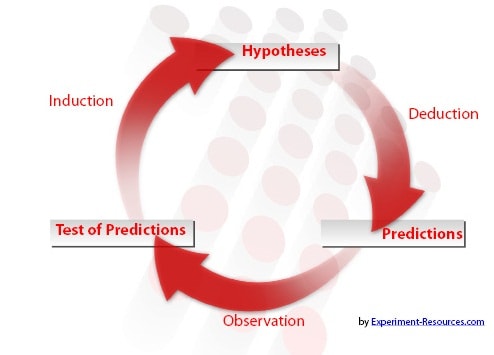

The hypothetico-deductive method is one of the mainstays of scientific research, often regarded as the only 'true' scientific research method.
This area fuels intense debate and discussion between many fields of scientific specialization.
Concisely, the method involves the traditional steps of observing the subject, in order to elaborate upon an area of study. This allows the researcher to generate a testable [3] and realistic hypothesis [4].
The hypothesis must be falsifiable [5] by recognized scientific methods [6] but can never be fully confirmed, because refined research methods may disprove it at a later date.
From the hypothesis [4], the researcher must generate some initial predictions, which can be proved, or disproved, by the experimental process [7]. These predictions must be inherently testable [3] for the hypothetico-deductive method [8] to be a valid process.

For example, trying to test the hypothesis [9] that God [10] exists would be difficult, because there is no scientific way to evaluate it.
The next stage is to perform the experiment [11], obtaining statistically testable results [12], which can be used to analyze the results and determine whether the hypothesis [4] has validity [13] or has little foundation. This experiment must involve some manipulation [14] of variables to allow the generation of analyzable data.
Finally, statistical tests will confirm whether the predictions are correct or not. This method is usually so rigorous that it is rare for a hypothesis to be completely proved, but some of the initial predictions may be correct and will lead to new areas of research and refinements of the hypothesis.
Proving and confirming a hypothesis is never a clear-cut and definitive process. Statistics [15] is a science based on probability, and however strong the results [12] generated; there is always a chance of experimental error [16].
In addition, there may be another unknown reason that explains the results. Most theories, however solid the proof, develop and evolve over time, changing and adapting as new research refines the known data.
Proving a hypothesis [9] is never completely accurate but, after a process of debate and retesting of the results, may become a scientific assumption. Science is built upon these 'paradigms [17]' and even commonly accepted views may prove to be inaccurate upon further exploration.
A false hypothesis does not necessarily mean that the area of research is now closed or incorrect. The experiment may not have been accurate enough, or there may have been some other contributing error.
This is why the hypothetico-deductive method relies on initial predictions; very few hypotheses, if the research [18] is thorough, are completely wrong as they generate new directions for future research.
Links
[1] https://explorable.com/hypothetico-deductive-method
[2] https://explorable.com/users/martyn
[3] https://explorable.com/testability
[4] https://explorable.com/research-hypothesis
[5] https://explorable.com/falsifiability
[6] https://explorable.com/what-is-the-scientific-method
[7] https://explorable.com/experimental-research
[8] http://philosophy.hku.hk/think/sci/hd.php
[9] https://explorable.com/hypothesis-testing
[10] https://explorable.com/when-science-meets-religion
[11] https://explorable.com/conducting-an-experiment
[12] https://explorable.com/statistically-significant-results
[13] https://explorable.com/types-of-validity
[14] https://explorable.com/independent-variable
[15] https://explorable.com/statistics-tutorial
[16] https://explorable.com/experimental-error
[17] https://explorable.com/what-is-a-paradigm
[18] https://explorable.com/what-is-research